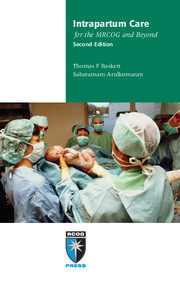Book contents
- Frontmatter
- Contents
- Preface
- Abbreviations
- 1 Improving intrapartum care
- 2 First stage of labour
- 3 Second stage of labour
- 4 Fetal surveillance in labour
- 5 Third stage of labour
- 6 Lower genital tract trauma
- 7 Induction of labour
- 8 Preterm labour and prelabour rupture of membranes
- 9 Assisted vaginal delivery
- 10 Shoulder dystocia
- 11 Breech vaginal delivery
- 12 Twin and triplet delivery
- 13 Caesarean section
- 14 Vaginal birth after caesarean section
- 15 Uterine rupture
- 16 Emergency obstetric hysterectomy
- 17 Cord prolapse
- 18 Antepartum haemorrhage
- 19 Postpartum haemorrhage
- 20 Acute uterine inversion
- 21 Amniotic fluid embolism
- 22 Disseminated intravascular coagulation
- 23 Acute tocolysis
- 24 Severe pre-eclampsia and eclampsia
- 25 Neonatal resuscitation
- 26 Perinatal loss: management of late fetal death and stillbirth
- Index
2 - First stage of labour
Published online by Cambridge University Press: 05 July 2014
- Frontmatter
- Contents
- Preface
- Abbreviations
- 1 Improving intrapartum care
- 2 First stage of labour
- 3 Second stage of labour
- 4 Fetal surveillance in labour
- 5 Third stage of labour
- 6 Lower genital tract trauma
- 7 Induction of labour
- 8 Preterm labour and prelabour rupture of membranes
- 9 Assisted vaginal delivery
- 10 Shoulder dystocia
- 11 Breech vaginal delivery
- 12 Twin and triplet delivery
- 13 Caesarean section
- 14 Vaginal birth after caesarean section
- 15 Uterine rupture
- 16 Emergency obstetric hysterectomy
- 17 Cord prolapse
- 18 Antepartum haemorrhage
- 19 Postpartum haemorrhage
- 20 Acute uterine inversion
- 21 Amniotic fluid embolism
- 22 Disseminated intravascular coagulation
- 23 Acute tocolysis
- 24 Severe pre-eclampsia and eclampsia
- 25 Neonatal resuscitation
- 26 Perinatal loss: management of late fetal death and stillbirth
- Index
Summary
Labour and delivery are sentinel events in a woman's life and her experience, good or bad, may have a profound effect on her attitude to her infant, her husband and the prospect of future pregnancy. In this context, the outcome of a woman's first labour and delivery is paramount. As O'Driscoll stated, ‘A woman who has had a happy first experience is unlikely to suffer much apprehension about a later birth, whereas a woman who has had an unhappy first experience is likely to be terrified at the prospect of a repeat performance. These fears can have grave consequences outside the narrow confines of obstetrics; they can haunt a woman for the rest of her life and affect her attitude to her husband and also possibly to her child.’
Primigravid labour is usually longer and more painful than subsequent labours; if the woman can be guided through her first labour to a safe vaginal delivery with physical and emotional security, her future obstetric experience is likely to be uncomplicated.
The first stage of labour starts with the onset of regular painful uterine contractions that lead to the progressive effacement and dilatation of the cervix, ending when the cervix has reached full dilatation.
Diagnosis of labour
Establishing the diagnosis of labour is the most basic and essential aspect of labour-ward management. In no other branch of clinical medicine do we expect the patient to make a diagnosis upon which will be based all future management. Happily, most women at term who present themselves to hospital believing they are in labour are correct. A presumed diagnosis of labour is based upon the onset of regular and painful contractions which are of increasing frequency and severity. This is often associated with a blood-stained mucous ‘show’ and, less often, rupture of the membranes.
- Type
- Chapter
- Information
- Intrapartum Care for the MRCOG and Beyond , pp. 9 - 18Publisher: Cambridge University PressPrint publication year: 2011



